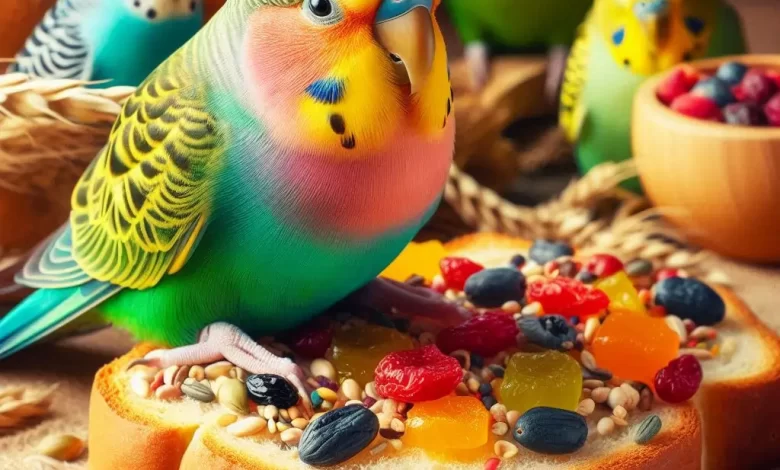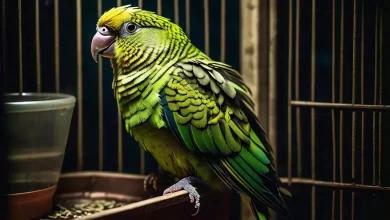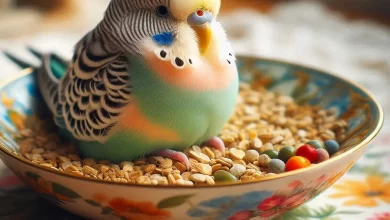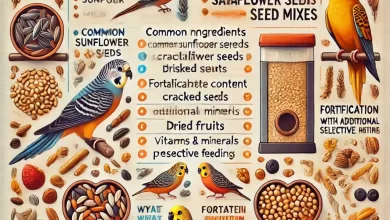How Many Parakeets Should I Get? A Complete Guide for New Bird Owners

Are you considering adding a feathered friend to your family? Parakeets, also known as budgerigars or budgies, are popular choices for both novice and experienced bird enthusiasts. However, a common question among potential owners is, “How many parakeets should I get?” This comprehensive guide will help you decide about parakeet flock size and care.
Parakeets are small, colorful members of the parrot family, known for their playful personalities and ability to mimic human speech. Whether you’re drawn to their cheerful chirps or vibrant plumage, you must understand that the number of parakeets you choose can significantly impact their well-being and your experience as a bird owner.
Several factors deserve careful consideration before deciding on single parakeet ownership or creating a mini-flock. Your living space, time commitment, budget, and experience level with birds are vital in determining the ideal number of parakeets for your situation. Understanding parakeet social needs and flock dynamics can help your new pets thrive in their environment.
This article will explore the pros and cons of parakeet flock sizes, from solo birds to larger groups. We’ll also cover essential care information, potential challenges, and expert recommendations to guide you through the decision-making process. Whether you’re a first-time bird owner or looking to expand your avian family, this guide will provide valuable insights into parakeet companionship and care.
So, let’s dive into the colorful world of parakeets and discover the perfect number of feathered friends for your home!
Factors to Consider When Deciding on the Number of Parakeets
Before bringing home your new feathered friends, it’s important to evaluate several crucial factors that will influence your decision on how many parakeets to get. Let’s dive into these key considerations:
Living Space
Housing requirements for parakeets play a significant role in determining the number of birds you can comfortably accommodate. Consider the following:
- Cage size: A single parakeet needs a minimum cage size of 18x18x18 inches, while a pair requires at least 30x18x18 inches.
- Flight space: Parakeets benefit from out-of-cage exercise. Ensure you have a safe, bird-proofed area for them to fly.
- Room layout: Think about where you’ll place the cage and how it will fit into your living space.
Time Commitment
The experience level of bird owners varies, but all parakeets require daily attention:
- Feeding and cleaning: Plan to spend at least 30 minutes daily on basic care.
- Interaction and training: Dedicate time to bond with your birds, especially if you have a single parakeet.
- Multiple birds: While they may entertain each other, they still need regular human interaction.
Budget
The cost of bird care goes beyond the initial purchase:
- Setup costs: This includes the cage, toys, perches, and other essentials.
- Ongoing expenses: Account for food, treats, replacement toys, and veterinary care.
- Bear in mind that multiple birds will proportionally increase these costs.
Experience Level
Your familiarity with bird care can influence the ideal number of parakeets:
- Beginners: Starting with one or two birds can help you gain experience.
- Experienced owners: You may feel more equipped to manage larger groups.
- Researching parakeet behavior and care requirements will help you assess your readiness.
Parakeet Social Needs
Understanding flock dynamics is essential:
- Social creatures: Parakeets thrive on companionship.
- Single parakeet: May require more attention from you to prevent loneliness.
- Pairs or small groups: They can provide each other with much-needed social interaction.
By carefully weighing these factors, you’ll be better equipped to choose the right number of parakeets for your home. The goal is to create a harmonious environment where you and your feathered companions can flourish.
The Case for Getting One Parakeet
Although parakeets are inherently social creatures, there are strong arguments for adopting just one bird. Let’s examine the advantages of single parakeet ownership:
Focused Bonding with the Owner
When you have only one parakeet, you become its primary companion:
- Stronger human-bird relationship: Your parakeet may form a deeper bond with you.
- Enhanced training potential: One-on-one attention often leads to better speech mimicry and trick training results.
- Personalized interaction: You can tailor playtime and activities to suit your bird’s preferences.
Easier Care and Management
Caring for a single parakeet can be more straightforward:
- Simplified cleaning routine: One bird means less mess and quicker cage maintenance.
- Focused health monitoring: It’s easier to notice changes in behavior or health when you’re caring for just one bird.
- Controlled environment: Managing diet, temperature, and other factors is less complex with a single pet.
Lower Costs
Owning one parakeet is generally more economical:
- Reduced initial investment: You’ll need a smaller cage and fewer accessories.
- Lower ongoing expenses: Minimized costs for food, toys, and veterinary care.
- Energy savings: A single bird may require less heating or air conditioning adjustment.
Ideal for Certain Living Situations
A solo parakeet can be a perfect fit for:
- Smaller living spaces: Where multiple birds might feel cramped.
- Households with noise restrictions: One bird is typically quieter than a pair or flock.
- Busy individuals: Those who can dedicate quality time but may not be home consistently.
Considerations for Single Parakeet Care
While there are benefits to having one parakeet, it’s essential to address their social needs:
- Increased interaction: Plan to spend more time with your bird to prevent loneliness.
- Environmental enrichment: Provide plenty of toys, mirrors, and stimulating activities.
- Consistent routine: Establish regular playtimes and interactions to keep your parakeet engaged.
Can parakeets live alone? The answer is yes, but they need attentive care. A single parakeet can thrive in the right environment with dedicated owner interaction. However, it’s vital to assess your ability to meet your bird’s social and emotional needs before deciding on solo parakeet ownership.
Ideal Parakeet Numbers for Different Situations
The perfect number of parakeets can vary depending on your circumstances. Let’s explore recommendations for different scenarios:
For Beginners
If you’re new to bird ownership, consider starting with:
- One parakeet: Allows you to focus on learning primary care without feeling overwhelmed.
- A pair: Provides social interaction for the birds while you gain experience.
Tips for novice owners:
- Start with young birds, which are generally easier to tame.
- Spend time interacting with your parakeet(s) daily to build trust.
- Join online forums or local bird clubs for support and advice.
For Experienced Bird Owners
Those with prior bird care experience might consider:
- Small flock (3-4 birds): Offers more complex social dynamics to observe and manage.
- Mixed-species aviary: Combining parakeets with compatible bird species for diversity.
Advanced care considerations:
- Monitor flock hierarchy and intervene if bullying occurs.
- Provide varied environments with multiple feeding stations and play areas.
- Be prepared for potential breeding if you have mixed-sex groups.
For Larger Aviaries
If you have ample space and resources, you might opt for:
- Medium flock (5-10 birds): Creates a lively, active environment mimicking natural flocks.
- Large colony (10+ birds): Suitable for dedicated enthusiasts with appropriate facilities.
Ideal Parakeet Numbers for Different Situations
| Situation | Recommended Parakeet Number | Additional Tips |
|---|---|---|
| Beginners | One parakeet or a pair | Focus on learning primary care without feeling overwhelmed. Spend daily time interacting with your birds. |
| Experienced Bird Owners | Small flock (3-4 birds) | Manage complex social dynamics. Monitor flock hierarchy and intervene if necessary. |
| Larger Aviaries | Medium flock (5-10 birds) or Large colony (10+ birds) | Create a lively, active environment. Ensure adequate space and multiple feeding stations. |
Aviary setup essentials:
- Ensure at least two cubic feet of space per bird; more is better.
- Provide multiple feeding stations, water sources, and nesting areas.
- Include a variety of perches, swings, and toys for enrichment.
Factors Influencing Ideal Flock Size
Consider these elements when determining your ideal parakeet number:
- Available space: Bigger cages or aviaries can comfortably accommodate more birds.
- Time commitment: Larger flocks require more time for care and cleaning.
- Budget: More birds mean higher costs for food, toys, and veterinary care.
- Local regulations: Check if there are limits on the number of pets allowed in your area.
Best Cage Size for Multiple Parakeets
Use this guide to ensure appropriate housing:
- Pair of parakeets: Minimum 30x18x18 inches
- 3-4 parakeets: At least 39x20x32 inches
- 5+ parakeets: Consider a walk-in aviary or custom-built large cage
Remember, these are minimum sizes. Always opt for the largest cage you can accommodate and afford.
By aligning the number of parakeets with your experience level, available space, and resources, you’ll create an environment where both you and your feathered friends can thrive. Whether you choose a single companion or a bustling flock, proper care and attention are crucial to ensuring happy, healthy parakeets.
How to Introduce Multiple Parakeets
Introducing new members to your parakeet flock requires careful planning. Following these steps can help ensure a seamless transition:
Gradual Introduction Techniques
- Quarantine period:
- Keep new parakeets isolated for 30-45 days to avoid potential disease transmission.
- Monitor for any signs of illness before merging them with your current birds.
- Visual introduction:
- Place the cages near each other, allowing the birds to see but not interact physically.
- Slowly bring the cages closer together over several days.
- Supervised interaction:
- After the quarantine, arrange short, monitored out-of-cage encounters.
- Begin with sessions lasting 10-15 minutes, then gradually extend the time.
- Neutral territory:
- Let interactions happen in a neutral space, not within any bird’s cage.
- Provide multiple perches and toys to minimize territorial tendencies.
Ensuring Compatibility
Look for these indicators of positive interaction:
- Chirping and singing to each other
- Mutual preening or sitting close together
- Sharing food or toys
Be aware of these warning signs:
- Aggressive actions such as biting or chasing
- One parakeet persistently bullying or dominating the other
- Excessive noise or distress calls
Tips for successful pairing:
- Pair birds of similar age and size whenever possible.
- Consider same-sex pairs to avoid breeding issues.
- Introduce younger birds to older ones gradually, as adults may be less tolerant.
Setting Up Proper Housing for Multiple Birds
Ensure your parakeets have a comfortable shared space:
- Cage size: Make sure the cage is large enough for all birds to fly and move freely.
- Multiple feeding stations: Offer separate food and water dishes to minimize competition, placing them at different heights.
- Variety of perches: Provide different types and sizes of perches to keep their feet healthy and ensure ample space for each bird.
- Enrichment items: Include various toys, swings, and mirrors. Regularly rotate these items to keep the birds entertained.
- Private spaces: Provide small huts or covered areas where birds can retreat if needed. Ensure these spaces are roomy enough to prevent territorial disputes.
Monitoring and Adjusting
Keep a close eye on interactions during the initial weeks:
- Be ready to separate birds if serious conflicts occur.
- Consult an avian veterinarian if persistent behavioral problems arise.
Remember, each parakeet has its personality. While some may bond right away, others might need more time. Patience and close observation are key when introducing new parakeets to your flock.
Potential Challenges of Multiple Parakeets
While keeping several parakeets can be a delightful experience, it’s crucial to anticipate possible challenges. Understanding these issues will help you manage your flock more effectively:
Increased Noise Levels
Parakeets are naturally vocal, and having more than one can amplify their chatter:
- Flock calling: Parakeets may chirp loudly to stay in touch with each other.
- Competitive vocalization: Birds might try to out-chirp one another for attention.
- Early morning noise: Multiple birds may start chattering as soon as dawn breaks.
Managing noise:
- Provide a quiet, dark sleeping area to encourage longer rest periods.
- Use cage covers at night to reduce early morning chatter.
- Engage your parakeets in quiet activities when a more peaceful environment is needed.
More Complex Care Requirements
Taking care of multiple parakeets can require additional effort:
- Feeding and nutrition:
- Observe each bird’s eating habits to ensure they’re all getting proper nutrition.
- Be aware of potential food competition or bullying.
- Health monitoring:
- Regular health checks become more vital with multiple birds.
- Illness can spread quickly in a flock, so swift action is necessary.
- Cage cleaning:
- More birds mean more frequent and thorough cleaning is required.
- Develop an efficient cleaning routine to maintain hygiene.
- Individual attention:
- Ensure each parakeet receives one-on-one time to keep them tame.
- Balancing attention between multiple birds can be tricky.
Possible Breeding Concerns
If your flock includes both male and female parakeets, breeding might become a concern:
- Unexpected breeding: Parakeets can breed at any time of the year in captivity.
- Egg-laying stress: Frequent laying can deplete a female’s calcium reserves.
- Territorial behavior: Breeding pairs might become aggressive towards other birds.
Preventing unwanted breeding:
- Consider keeping same-sex pairs if chicks are not desired.
- Consult an avian veterinarian about hormone regulation options.
- Adjust light cycles and remove nesting materials to discourage breeding.
Flock Dynamics and Behavioral Issues
Managing multiple personalities can be challenging:
- Bullying or aggression: Dominant parakeets might pick on more submissive ones.
- Pair bonding: Two birds might bond closely, excluding others.
- Stress from overcrowding: Too many birds in a small space can lead to tension.
Reducing parakeet stress:
- Ensure there is enough space and resources for all birds.
- Arrange the cage to break sight lines and create separate areas.
- Intervene early if persistent aggressive behavior is observed.
While these challenges exist, many can be mitigated with thoughtful planning, proper care, and consistent attention. By being aware of potential issues, you can foster a harmonious environment for your parakeet flock, ensuring a positive experience for both you and your feathered companions.
Expert Recommendations
To offer you the most reliable insights on parakeet care and flock management, we’ve consulted with avian veterinarians and experienced parakeet owners. Their knowledge can guide your decisions and enhance your birds’ quality of life.
Advice from Avian Veterinarians
Dr. Sarah Featherstone, DVM, Certified Avian Specialist:
“When considering parakeet flock dynamics, I usually suggest starting with a pair. This provides companionship for the birds while keeping care manageable for new owners. However, it’s vital to monitor their interactions and be ready to separate them if issues emerge.”
Key points from Dr. Featherstone:
- Regular health check-ups are crucial, particularly in households with multiple birds.
- Offer a varied diet that includes pellets, fresh vegetables, and limited seeds.
- Ensure proper ventilation to maintain good air quality for your birds.
Dr. Michael Avian, PhD in Ornithology:
“Parakeets are social creatures with intricate communication systems. We must replicate their natural social structures as much as possible in captivity. However, this doesn’t necessarily mean adding more birds – the quality of interaction is just as significant as the quantity.”
Dr. Avian’s recommendations:
- Observe natural flock behavior to better understand your parakeets’ needs.
- Provide environmental enrichment to encourage natural behaviors.
- Consider the individual personalities of your birds when expanding your flock.
Insights from Experienced Parakeet Owners
Maria Thompson, 15-year parakeet enthusiast:
“I’ve found that a small flock of 3-4 parakeets offers an excellent balance. They keep each other company, but it’s still manageable in terms of care and attention. The key is to introduce them gradually and provide plenty of space.”
Maria’s tips:
- Rotate toys regularly to keep your birds engaged and prevent boredom.
- Establish a consistent daily routine for feeding and interaction.
- Pay attention to each bird’s unique personality and adjust care accordingly.
John Peterson, parakeet breeder with 20 years of experience:
“While breeding parakeets can be rewarding, it’s not for everyone. If you’re not prepared for the responsibility of caring for chicks, it’s best to stick with same-sex pairs or take steps to prevent breeding.”
John’s breeding insights:
- Recognize the signs of breeding behavior to avoid unexpected chicks.
- Provide adequate nutrition for breeding pairs to ensure healthy offspring.
- Be ready for the time commitment required to hand-raise chicks if necessary.
Consensus Among Experts
Despite some differences in opinion, most experts concur on the following points:
- Social interaction is essential for parakeet well-being, whether from other birds or humans.
- The ideal number of parakeets depends on the owner’s experience, available space, and time commitment.
- Regular veterinary care, a balanced diet, and mental stimulation are crucial for all parakeet setups.
- Careful introduction and monitoring are vital when adding new birds to an existing flock.
By combining these expert recommendations with your personal circumstances, you can make an informed decision about the ideal number of parakeets for your home.
Parakeet Care Essentials
Understanding and implementing proper care is fundamental for your parakeets’ health and happiness, regardless of how many you choose to keep. This section outlines the essential aspects of parakeet care:
Diet and Nutrition
A balanced diet is crucial for your parakeet’s well-being:
- Pellets:
- Should make up 60-70% of the diet
- Provide essential nutrients in balanced proportions
- Fresh fruits and vegetables:
- Offer 20-30% of the diet
- Include leafy greens, carrots, apples (without seeds), and berries
- Seeds:
- Limit to 10% of the diet as treats
- High in fat, so use sparingly
- Fresh water:
- Change daily and clean water dishes regularly
Feeding tips:
- Introduce new foods gradually.
- Remove fresh foods after a few hours to prevent spoilage.
- Use multiple feeding stations in multi-bird setups to avoid competition.
Health Considerations
Regular health monitoring is essential:
- Annual check-ups:
- Schedule yearly visits with an avian veterinarian.
- Include physical examinations and necessary tests.
- Common health issues to watch for:
- Respiratory problems (wheezing, tail bobbing)
- Overgrown beaks or nails
- Feather plucking or abnormal molting
- Hygiene:
- Clean the cage daily.
- Perform deep cleaning weekly.
- Use bird-safe disinfectants.
- Exercise:
- Provide daily out-of-cage time in a safe, supervised area.
- Encourage flying and climbing for physical health.
Enrichment and Toys
Mental stimulation is vital for your parakeets’ well-being:
- Types of toys:
- Foraging toys to encourage natural behaviors.
- Mirrors (use cautiously as some birds may become overly attached).
- Swings and ladders for physical activity.
- Chew toys for beak maintenance.
- Rotation schedule:
- Change toys every 1-2 weeks to maintain interest.
- Introduce new toys gradually to avoid stress.
- Natural perches:
- Offer various sizes and textures for foot exercise.
- Include some soft wood perches for nail maintenance.
- Interactive play:
- Spend time daily engaging with your parakeets.
- Use training sessions for mental stimulation.
Creating the Ideal Environment
Proper housing is a cornerstone of parakeet care:
- Cage size:
- Bigger is always better.
- Ensure enough space for flight within the cage.
- Cage placement:
- Away from drafts and direct sunlight.
- In a room with regular family activity.
- Temperature:
- Maintain a consistent temperature between 65-80°F (18-27°C).
- Avoid sudden temperature changes.
- Lighting:
- Provide 10-12 hours of light daily.
- Consider full-spectrum lighting for indoor birds.
- Air quality:
- Ensure good ventilation.
- Avoid exposure to household fumes or smoke.
By attending to these care essentials, you’ll create a healthy, stimulating environment for your parakeets, regardless of flock size. Consistent care and attention are vital to raising happy, thriving parakeets.
Conclusion
Deciding on the number of parakeets to keep and understanding how to properly care for them are pivotal aspects of ensuring a healthy and harmonious environment for your feathered friends. Whether you opt for a single parakeet or a bustling flock, each choice comes with its own set of considerations and responsibilities.
Factors such as living space, time commitment, budget, and your experience level play significant roles in determining the ideal number of parakeets. A single parakeet offers unique benefits, including a focused bond with its owner and simpler care requirements. Conversely, multiple parakeets can provide social interaction and a lively atmosphere but come with increased noise, care complexity, and potential breeding concerns.
Introducing multiple parakeets requires a careful and gradual approach. Start with a quarantine period, ensure compatibility through supervised interactions, and set up proper housing to accommodate all birds comfortably. Regular monitoring and adjustment are crucial to maintaining peace within the flock and addressing any emerging issues promptly.
While managing a flock presents challenges, expert recommendations emphasize the importance of social interaction, regular veterinary care, a balanced diet, and environmental enrichment. By implementing these practices and tailoring them to your specific situation, you can create a thriving environment that promotes the well-being of your parakeets.
Thank you for exploring the world of parakeet care with us. Your commitment to providing the best for your feathered friends is commendable. If you found this guide helpful, we encourage you to explore more articles on our website for additional tips and insights. Don’t hesitate to reach out with any questions or share your own experiences in the comments below. Together, let’s create the best possible environment for our beloved parakeets!




